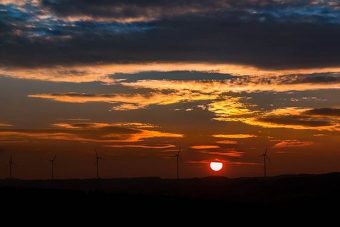
As the host of this year’s COP22 climate change conference in Marrakech, Morocco has been keen to demonstrate its green credentials and make this COP the “African COP”.
In the past year, Morocco has banned the use of plastic bags, launched new plans for extending the urban tram networks in Casablanca and Rabat, started the process of replacing its dirty old fleet of buses and taxis, launched Africa’s first city bicycle hire scheme, and launched a new initiative – the “Adaptation of African Agriculture” – to help the continent’s farmers adjust to climate change.
But by far the most attention has been on the development of “mega” infrastructure projects in an ambitious plan to transform the country’s energy mix.
Morocco has no fossil fuel reserves so is almost entirely reliant on imports. In 2015 King Mohammed VI committed the country to increasing its share of renewable electricity generation to 52% by 2030, aiming for the installation of around 10 gigawatts (GW). Of that, 14% is expected to come from solar, with plans to install 2GW of new capacity by 2020, as well as increases in wind power and hydraulic dams. Morocco has even opened the door to exchanging electricity produced from renewable sources with Europe.
Morocco’s INDC (Intended Nationally Determined Contribution) plan submitted to the UNFCCC is equally ambitious and commits the country to cutting greenhouse gas emissions – particularly in agriculture – by 32% by 2030, compared to business as usual. Morocco has also committed to planting 200,000 hectares of forest (pdf) and greatly increasing in irrigation. The commitment is dependent on accessing climate financing, but translates to a cumulative reduction of 401 megatonnes of C02 over the period 2020-30. In 2015 Morocco completely removed subsidies on petroleum products.
The first phase of the giant Noor solar complex near Morocco’s southern desert town of Ouarzazate is the 160MW Noor One plant, which was opened by the king in February. Instead of PV (photovoltaic) solar panels, Noor uses CSP (concentrated solar power) technology – giant mirrors to reflect the sun’s rays on to tubes containing liquid which is super-heated to drive turbines. CSP offers storage of electricity for up to three hours after the sun has set, which covers peak demand times.
Close to the site of Noor One, Noor two, currently under construction, will use the same CSP technology, but on a bigger scale with the hope of storing electricity for seven hours. Noor Three however will use a new variant on CSP technology – the solar tower, where the mirrors are directed at a central point.
Between them they will add another 350MW to the national grid, and are expected to be completed by 2017/18. Noor Four will be constructed near the High Atlas town of Midelt and Morocco’s renewables agency, Masen, announced this week at COP22 that it would open the bidding for two 400MW combined PV and CSP plants in early 2017.
Morocco is also investing in wind. A consortium of Enel Green Power, Nareva (owned by King Mohammed VI’s investment company) and Siemens won a bid in March to build five new wind farms at different sites across Morocco – Midelt, Tangier, Jbel Lahdid, and Tiskrid and Boujdour in the disputed Western Sahara territory. Their combined capacity will be 850MW, a huge increase taking Morocco closer to its aim of producing 14% of electricity from wind by 2020. The unit cost in the tender documents was one of the lowest in the world, at just $0.03 per kWh.
But while developing renewable power sounds good on paper, cost will be a big factor. The launch of the Noor CSP project has helped the price of electricity produced by CSP to come down to around $0.16 per kWh, but that looks expensive compared to solar PV which has fallen as low as $0.03 per kWh.
It remains to be seen whether the costs of CSP will fall low enough to be globally commercially competitive, and deliver cost-effective renewable power for Moroccan consumers. CSP also uses large amounts of water to keep the mirrors clean – a real problem in water-stressed Morocco. At the same time, Morocco has not totally kicked the fossil fuel habit – coal still makes up the biggest part of energy production today (35%) and is set to be expanded over the next five years. The new energy mix will include at least 3,900MW of energy from natural gas, and the search for hydrocarbon deposits on Moroccan soil continues.
Source: theguardian.com




